So, are you looking to expand your knowledge of the ins and outs regarding the different parts of a turntable and trying to get a firmer grasp of the logistics of what makes the vessel for your favorite music tick?
Or, perhaps your turntable is not quite working as it should and, in attempting to get to the bottom of it yourself, you are looking to understand a little better the various parts of a turntable and how they do what they are supposed to do.
Whatever your motives for being here, may I welcome you as we attempt to elucidate for you the parts of a turntable and how getting to know them on your own terms can be a sure fire way to ensure that you will no longer need to hire a professional when something goes wrong.
Table of Contents
- Parts of a Turntable Record Player
- Plinth
- Platter
- Drive
- Tonearm
- Cartridge
- Final Tones
- FAQs Parts of a Turntable
Parts of a Turntable Record Player
These are the five major components of a record player we will dive in deeper
- Plinth
- Platter
- Drive
- Tonearm
- Cartridge
There are a few more minor elements that you can check out on the graph below.
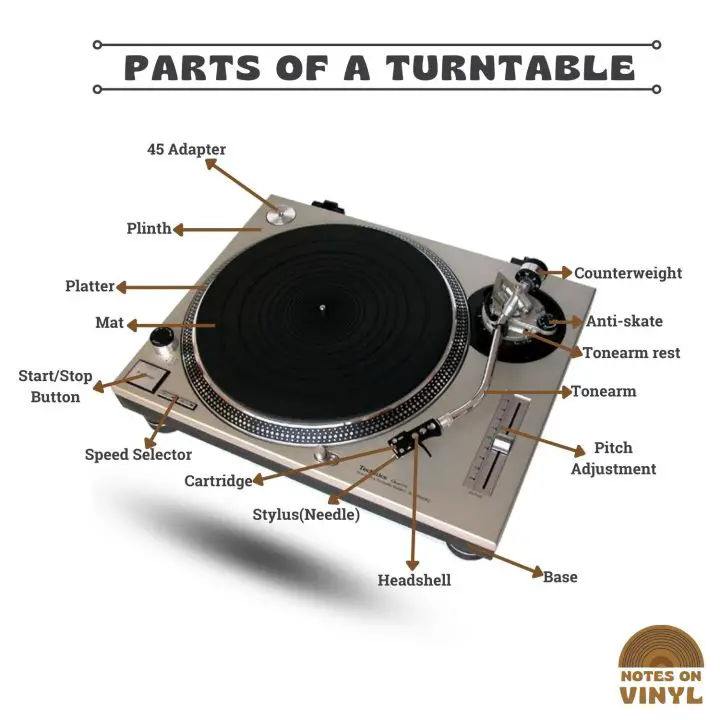
Plinth
The plinth is one of the parts of a turntable that is not as often referred to by its formal name, perhaps more commonly known simply as the support for the record player, that which it is set upon. The plinth does not have an impact on the tonal qualities of the record in question, but instead seeks to lay a strong foundation that would be very different indeed were there a weaker foundation.
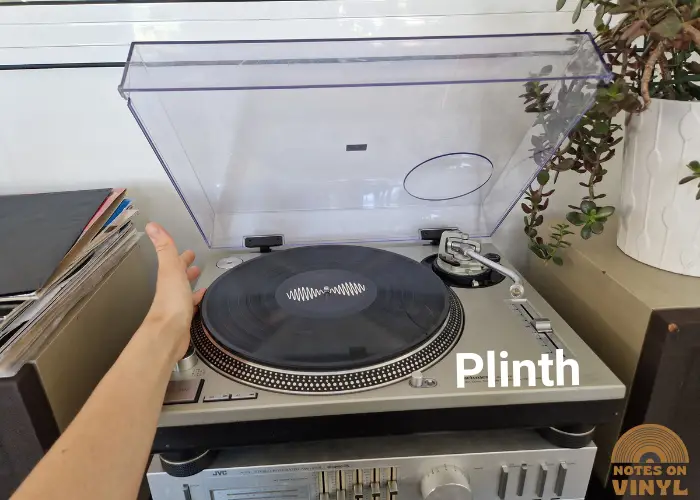
All around us at almost every hour there are vibrations ceaseless, both large and small and every shade in between, all of which can exert an influence of sorts on the turntable’s ability to spin records properly and without any interruptions, to greater and lesser extents of course.
In more dramatic instances, however, these vibrations can even knock the needle off its course and send it hopping all over the face of the record, spoiling what might otherwise have been a sanctimonious listening experience. And, eventually, lead to a need to replace your record needle.
The plinth, thus, inserts itself into the canon, of parts of a record player attempting to lay enough of a foundation that the record player, to the best of its ability, is unaffected by these irksome external vibrations.
Some plinths further extend their role from simply laying foundations to going as far as modifying the foundations of the surface upon which the turntable is set.
This kind of record player plinths come with adjustable feet, which can be so adjusted to cater to the various gradations and crenulations on the sloping surface on which the turntable might be set.
This will no doubt be of far more use to the turntable user and record collector who does not have the means to install their setup onto an entirely level surface. In fact, I might go as far to say that such a gadget will be deemed essential in such circumstances.
Platter
Of the parts of a turntable, if the plinth is the part that absorbs those pesky external vibrations that have all too often penetrated a sanctimonious listening atmosphere by seeking and destroying the needle in its tracks, then the platter is the part of the record player that the plinth is protecting.
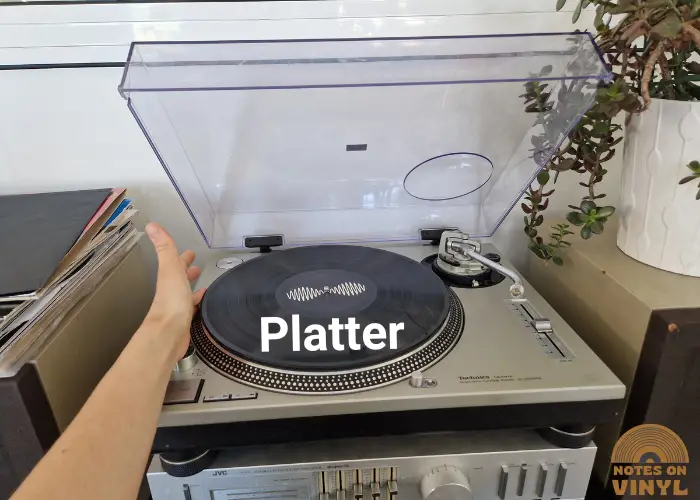
Though the platter’s job might seem mighty simple, it is only so for how integral a part of the process it is and how important it is as one of the machinations of the turntable, being that which makes first contact with the disc that you wish to play.
In mirroring the shape of the discs which it is intended to meet, the platter is likewise circular. Most will come already fitted with a turntable mat (or what those in the know will refer to as a slipmat), usually made from rubber or felt, that is going to do the record a good service.
The platter fulfills a dual purpose of extra absorption of vibrations that the plinth might otherwise miss, as well as making use of the form to further advertise the particular brand of hi-fi or audio equipment that the turntable is made by (or even one’s own musical leanings, if so inclined).
It would be silly for a turntable or turntable platter to come without a slipmat, in fact, since the latter is usually made from a far coarser material – a metal or plastic disc-shaped surface – that is not going to do the records any favors. Thus, a slipmat will be more than necessary in protecting the discs from extra scratches they might pick up along the way.
Drive
So, after the plinth and the platter, the drive will be the next most important thing for actually getting running and running smoothly. The drive is the part inside any turntable or record player that sets the platter a-spinning, one of the only parts of a record player wholly dedicated to motion.
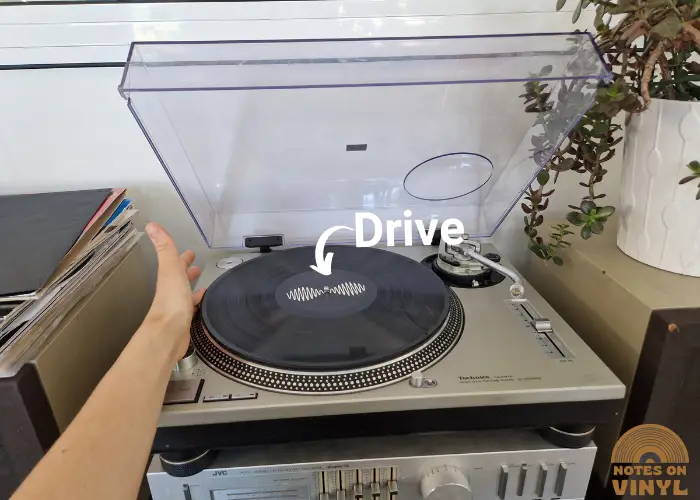
There are two commonly used types of drive that can be found in basically every turntable, those being the: direct drive vs belt drive turntables. The latter is the older of the two and comes from the earlier generations of record players history, comprised of a rubber belt that is driven to mechanically transfer the kinetic motion of the motor to the platter above, in an attempt to spin it at a more or less consistent speed.
The former, the direct drive, is a relatively newer invention that came to be as result of turntablism by disc jockeys (or DJ’s), who would scratch a record and improvise like so just as a saxophonist might within a jazz context.
The motor and drive in these kinds of drives are more or less working as one, with a far smaller gap between them resulting in a near negligible gap between the pressing of a button and the enacting of the action of it.
Both the belt drive and the direct drive have their own advantages and disadvantages. The former, for example, is far better at absorbing extra vibrations, doing so alongside the platter and the plinth to render them almost non existent. The direct drive, on the other hand, is far superior at its intended purpose, that being to start and stop as quickly as possible, to demolish the gap between the stopping of the platter (either by hand or button) and its starting up and returning to the previous speed.
Tonearm
As the parts of a turntable go, the tonearm is no less important, acting as the conduit for and bearing the integral needle/stylus cartridge. In fact, the right calibration of the tonearm is one of the more important aspects of expensive and boutique record players or at least those from a bygone era where this was more important.
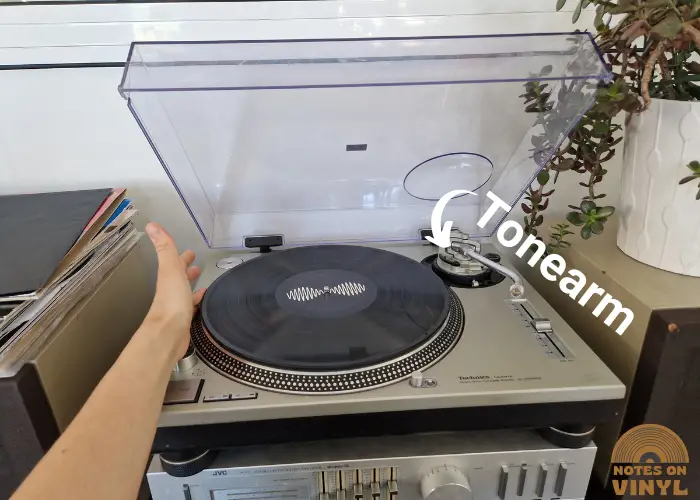
There has been an increasing trend among modern turntables, particularly in those whose manufacturer has done so at a cheaper cost – whether all in one or otherwise – to not include any options to adjust or calibrate the tonearm whatsoever. Needless to say, this can have a deteriorating effect on a record collection over time, leading it to last far less than it might otherwise. There are, however, plenty of modern turntables that do include these kind of options, to ensure that the tonearm enacts just the right amount of pressure, enough that the sound is transmitted but that the tonearm is not pressing too deeply in.
Just as the tonearm can exact too much pressure onto the surface of a record, it can also veer too much to the left or right in a similar act of rebellion against one’s own personal sense of justice in physics. This is where such things as anti-skate measures come into play, working on more expensive models of record players or those from a bygone era of when were record players popular, to rectify this very issue and to ensure that the stylus stays on the right track throughout its journey.
Cartridge
Of the parts of a turntable, we will finish our journey by discussing that which is directly connected to the tonearm and which is held aloft upon it the decapitated head of a former monarch.
And that is the kind of regard which the cartridge ought to be held in, for it is one of the only parts of the record player that comes into direct contact with the record itself, and the only one which is tasked with reading and transmitting the sensitive vibrational data from the disc’s grooves and out through the preamp and speakers. No small feat!
So, while the turntable platter turns and spins the record in question, the vibrational data set within the grooves of the record travel through the needle attached to the cartridge and into it, wherein there are coils arranged in a field that is not unlike a small electromagnetic generator, converting the kinetic vibrational energy into an electrical signal.
The cartridge will usually be made from plastic or metal, though the stylus at the tip will be crowned with a very small piece of diamond, attached as it is to a flexible and ductile metal strip.
Diamond is often the main choice for these things, though there are a choice selection of other precious rocks that act as conductors in just as effective a way, including but not limited to: sapphire, ruby, boron, carbon fiber etc.
No matter the material, however, it has to be ready and willing to be as durable as can be, for it is going to be subjected to countless hours and hours of playback which, if rendered in mileage, might make any car’s engine go gaseous in fright.
It should therefore come as little surprise that stronger precious rocks like diamond or alloys like carbon fiber are used for the job, capable as they are of withstanding long and hard tasks at the grindstone of the turntable’s revolutions.
Final Tones
So, there you have it! Hopefully, you are feeling wiser about the various record player parts, what they do, how and why they do, and why getting to know these things better is for the best. It is also our hope that you are feeling incensed to learn more in the future about these things and to do so at your own behest.
FAQs Parts of a Turntable
What are the parts of a turntable?
There are several parts of a turntable, all of which are integral to the adequate work of the turntable in their own way. The plinth is that on which the turntable resides; the platter is that on which the disc is set and which spins; the drive is that within which spins the platter; the tonearm is that which supports the cartridge; the cartridge is that containing the stylus which transmits vibrational data into sound; and the preamp transposes these signals into volumes loud enough to hear.
What are the parts of a vinyl record called?
Being a rather simple disc shape, there are not so many parts of a record, though it is certainly worth knowing them, in preparation of the eventuality that you might have to use these terms to describe a problem to a professional or seller. There is the label or center sticker on which information is printed; there is the edge which will be held by the consumer to put the disc onto the platter; there is the center hole which is pierced with the spike at the center of the record players platter; and there are the grooves which hold the musical data.
What is the thing called on a record player?
The plinth of a turntable is the base on which the device is situated. The platter is the part the disc is placed on and spins. Inside the drive is where the platter rotates. The tonearm supports the cartridge, which contains the stylus that converts vibrations into sound. Finally, the preamp amplifies these signals so they can be heard.
What is the most important part of a turntable?
None of the parts of a turntable are more important than any others, certainly not enough to warrant being labelled so. Over time, the design of the turntable has become so streamlined that none of the parts can really be dispensed with, without of course nullifying the adequate and lubricated functioning of the turntable as a whole.
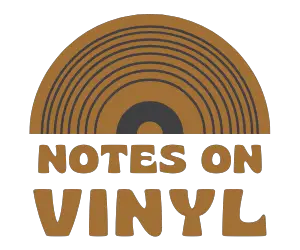





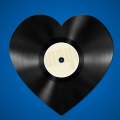


1-I appreciate the information provided about the different parts of a record player. 2-I have a question though. What part of the record player uses a lubricant to help it run smoothly? Thank you for the information.
Hey there Veronica, hope this finds you well.
Thanks very much for the comment – it is for the appreciation and assistance of enthusiasts such as yourself that we do what we do here at Notes on Vinyl. In answer to your question, it will usually be the motor and the various cogs that drive it and the belt drive forth that is lubricated in order that they move without rubbing against one another. As you may well know from science class (or just from personal experience), friction produces heat, and heat produces fire, which could spell disaster for any record player. If you open up your record player (gently), you will be able to see it for yourself – usually of a color and consistency similar to PVA glue.
Hope this helped in whatever and don’t be afraid to get in contact again!
Robert.